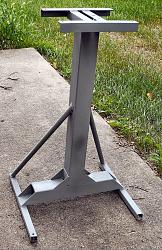Current project is a stand for a belt sander. I got this really cool 2” Kalamazoo belt sander about a year ago. It is a remarkable tool for shaping metal and other materials.
https://www.kalamazooind.com/product...e-belt-sander/
Here’s the stand before I mounted the sander:
The column and bottom cross piece are 2-1/4 x 2-1/4 x 1/8” square steel tube I had laying around.
It was very rigid side-to-side but not quite rigid front-to-back so I added the diagonal braces. They’re made out of conduit from Home Depot. That stiffened it right up. It’s now solid as a big tree stump.
I made little feet for it, 3 fixed feet made of nylon and a fourth with a thin rubber foot that is adjustable to compensate for any irregularities in the floor by screwing it in or out. It fits into a threaded socket that is welded into the foot piece. It’s a thin stainless steel disc brazed to a ¼-20 bit of allthread with a rubber disc glued on the bottom.
The hardware store didn’t have pan head 10-32 machine screws so I grabbed these screws in an ER-25 collet and skinned them down in the lathe.
Here they are on the stand:
I had to re-make two of the nylon feet after the two that were in place got melted when I welded the braces to the foot members.
Here’s the finished job with sander mounted and ready to go to work.
The jelly roll pan came from Target for $1.99. It’s to catch dust and grit from sanding/grinding activities.
To make the compound angles on the oblique braces I first figured the various angles using 3D modeling and drafting techniques. The smaller bottom angle I just cut with a chop saw that has a miter gage. The top cut is at too steep an angle for the chop saw’s miter gage (23 degree included angle) and it’s plane is rotated from the plane of the bottom cut by 46 degrees. I calculated the X-Y coordinates of a pattern which, when rolled around the tube, would present a line to cut to. Then I sent that set of coordinates to AutoCAD to plot the curve on my printer to make a pattern. It looked like this:
The horizontal X dimension here is circumference of the tube, 360 degrees from left to right. The plot is the locus of the cut line described by
where Y is the vertical position of the locus, is 23.2 degrees, the angle of the cut, r is the radius of the tube and is angle of rotation around the tube. The 46 degrees is the angle of rotation between the planes of the two diagonal cuts.
Here the pattern is rolled around the tube and taped in place with the vertical line aligned with the tube’s axis:
As you can see, when wrapped around the right diameter cylinder it looks like the diagonal cut I needed to make. I then cut to the line with my band saw and then gave them a quick touch on the belt sander to clean them up. Then I welded them to the stand.


 LinkBack URL
LinkBack URL About LinkBacks
About LinkBacks









 Reply With Quote
Reply With Quote



Bookmarks